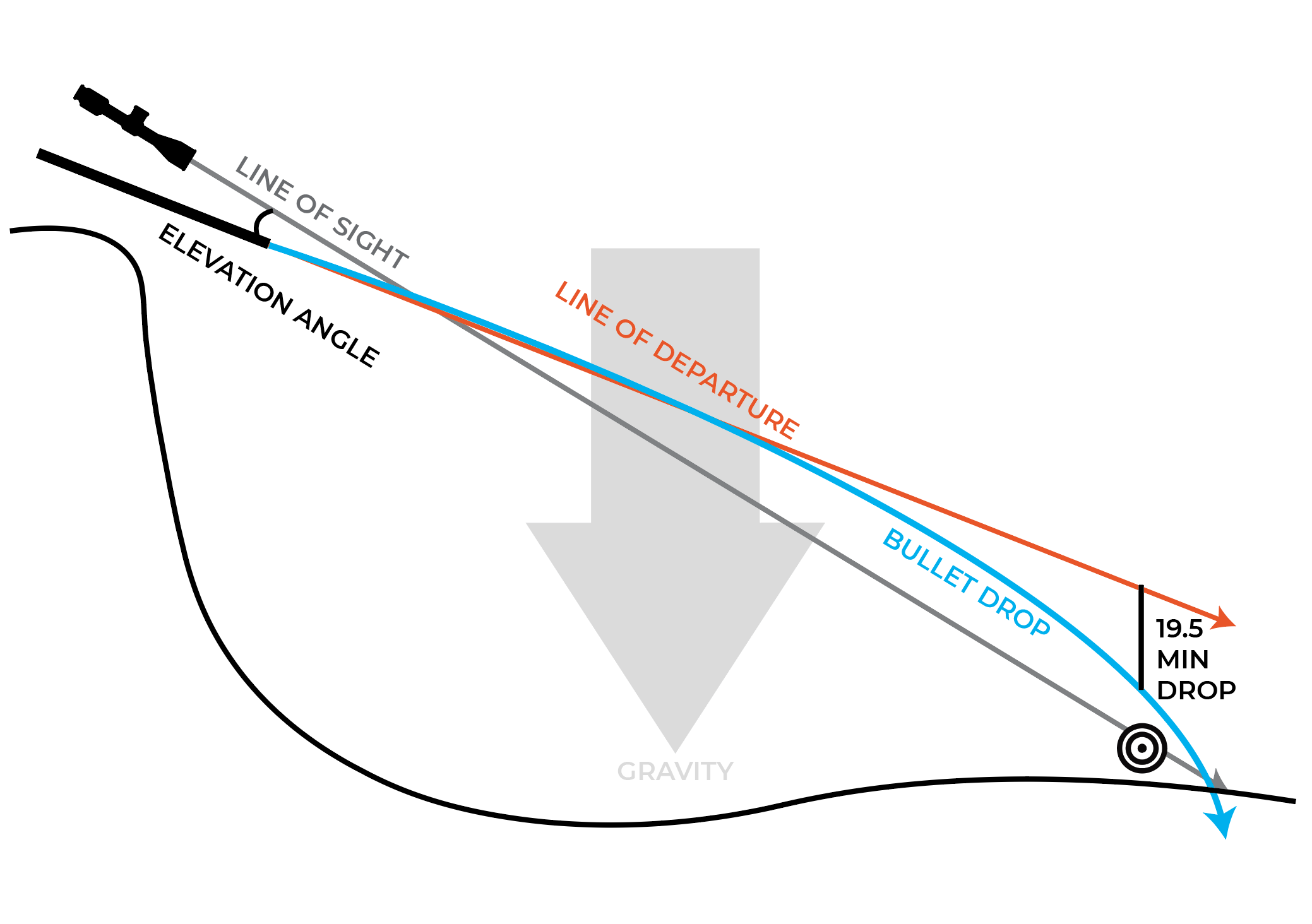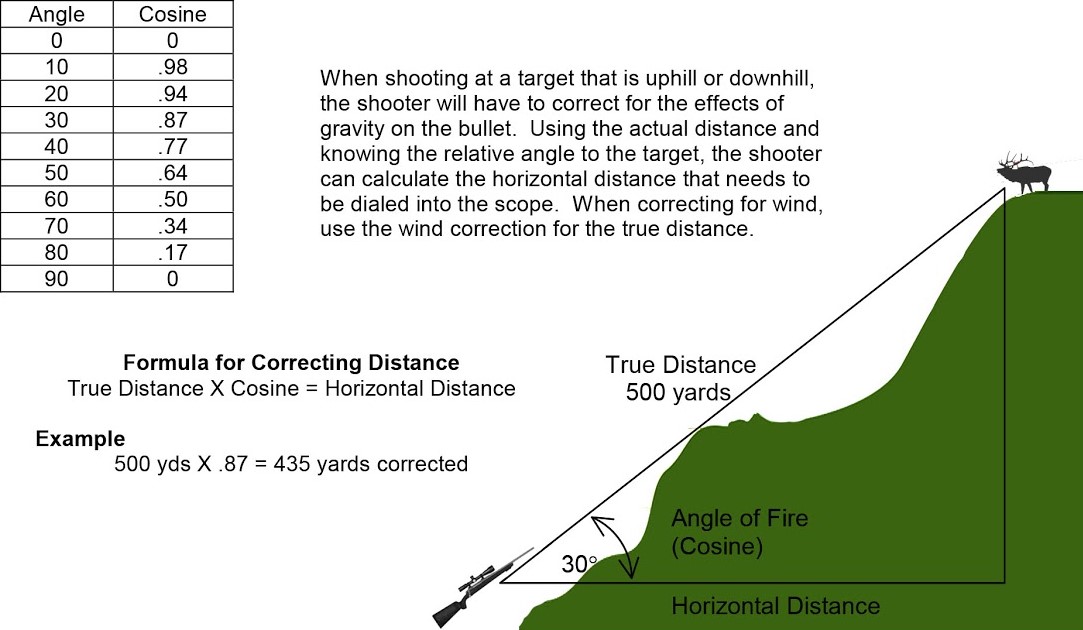The inclination of a long range shot can have a major impact on the scope elevation setting needed. If you fail to take steep inclination into account, your impact will always be high. It does not matter if you are shooting up at a target, or down at a target, your impact will be high. Our goal at Gunwerks Long Range University is to provide you with the education necessary to understand the effect, and the technology which will make compensating for it in the field as simple as possible.
To understand it, first let’s review some terminology.
Minute Of Angle (MOA)
A minute of angle is an angular measurement which equals 1/60th of a degree. For our purposes it equals approximately 1 inch at 100 yards, 2 inches at 200 yards, 10 inches at 1000 yards and so on.
Line Of Departure
This is the line which travels down the long axis of the bore of your rifle and continues in a straight line. If a bullet was fired in an environment where there was no gravity, the bullet would travel along this line.
Trajectory
This is the actual path that the bullet follows down range, which deviates from the line of departure due to the effects of gravity. Absent gravity, the bullet would remain traveling on the line of departure. Gravity normally pulls at a right angle to the line of departure when we shoot on level ground. Inclination affects the path of the bullet because it changes that right angle relationship between the force of gravity and the line of departure.
Line Of Sight
The line of sight is a straight line from your eye, through the scope, and to the target. The line of departure will not be parallel to the line of sight, but will point slightly upwards in relationship to the line of sight. Therefore, the bullet will cross the line of sight twice during its flight. Due to the angle, the bullet starts below the line of sight. Shortly after leaving the muzzle, the bullet will cross the line of sight and travel above it, until the force of gravity pulls it back down to where it crosses the line of sight again.
Zero Range
The zero range is either point that the bullet crosses the line of sight. It will cross the line of sight somewhere between 15 and 50 yards, then travel above the line of sight until gravity pulls it down and it crosses the line of sight again. Where this happens depends upon the amount of elevation that the shooter places on the scope. If the shooter zeroes his rifle at 100 yards, the angular difference between the line of departure and the line of sight will be very low, or close to parallel. With a 1000 yard zero, the angular difference between the line of departure and the line of sight will be much greater.
Bullet Drop
The distance that the bullet has fallen below the line of departure at any given range. This may be measured in minutes of angle or inches.
Inclination is important to the shooter because it changes the amount of apparent bullet drop at a given range. When a bullet is traveling in a horizontal direction, the pull of gravity is perpendicular to the path of the bullet, therefore as the range increases, the bullet drops farther below the line of departure. When the bullet is traveling at an up or down angle, the pull of gravity is no longer perpendicular to the bullet path. The bullet will still drop the same amount at any given range, however the bullet’s apparent movement in relationship to the line of departure will decrease. This is true regardless if the shooter is firing at an up or down angle.
Shooting Flat
Why Does Inclination Matter? This is how things look for a level shot. Gravity is Pulling perpendicular to the path of the bullet (angle between line of departure and line of sight is exaggerated).

Shooting On An Incline/Decline
Once we add an incline/decline to the shot, gravity is no longer perpendicular to the path of the bullet. The bullet still drops 19.5 MOA, but its drop in relation to the line of departure is lessened. Impact will be high regardless if shooting up or down.

The “Rifleman’s Rule” or “Map Distance Method”
Many shooters are familiar with the “Rifleman’s Rule” or the “Map Distance” method for dealing with inclination. This method which I will call the “Map Distance Method” works well in many applications, but it is not perfect. It overcompensates at ranges past 500 yards and angles greater than approximately 20 degrees.
To understand the Map Distance Method, there are two terms which we will be concerned with. The first is “true distance”. This is the actual distance from your muzzle to the target as determined by a laser rangefinder. The second is “map distance”, which is the horizontal distance from you to the target as seen from above. To determine map distance from true distance, you multiply the true distance times the cosine for the angle.

For example if your straight line distance is 500 yards, and the angle is 30 degrees, you multiply 500 X .87 This equals 435 which is the map distance to your target. You set your elevation for 435 yards and take the shot. This method, while not completely mathematically correct, is sufficient for short and medium range shooting.
Measuring Angles
The average person standing on top of a mountain looking down at a point below will significantly overestimate the angle. In reality most people will look at a 20-degree angle and call it a 45-degree angle.
Most high quality laser rangefinders have an option to display the angle. Beware because in some settings some will automatically display the “map distance”. There are several companies such as “Mil Dot Master” that make small laminated tools for snipers which have an attachment point for a string and weight to measure angles.
Preferred Method
The “Map distance” method is not completely accurate for the following reason. The bullet’s trajectory is a parabola meaning an “ever increasing curve”. This means that the rate of drop does not have a linear relationship with the distance to the target. When we use the map distance method we are basically applying a linear solution to a non-linear problem. To use the preferred method we need to know the amount of bullet drop in MOA for the true distance.
Example
The previous problem, 500 yards at a 30 degree angle assuming a 6.5 Creedmoor with a 140 gr. bullet at 2,700 fps. That range (500 yds) without any angle would require approximately a 9.6 MOA up adjustment from our 100 yard zero. If we adjust up to 435 yards instead of 500 (500 X.87 = 435) we are coming up 7.7 MOA as opposed to 9.6 MOA, a correction for the angle of 1.9 MOA.
To complete the problem correctly we need to apply the cosine to the amount of bullet drop, not the range. So we have 9.6 MOA of bullet drop at 500 yards. 9.6 X .87 = 8.4. Now we adjust up 8.4 MOA from our 100 yard zero instead of 9.6 Note that using the map distance method we only came up 7.7 MOA instead of 8.4 MOA which is correct.
The reality is as the distances increase (beyond approximately 500 yards) and the angles get steeper (over 30 degrees), the map distance method overcompensates and causes low impacts.
Ballistic Turrets
If you have ballistic turrets on your rifle, it is easier to attack the problem from the other direction because you are used to dialing for the range as opposed to counting minutes up from your 100 or 200 yard zero. To use the preferred method you will still need to know the drop in MOA at any given range. Also instead of using the cosine, we will use the sine, which is merely the inverse number, so that when added to the cosine would equal 1.
For example for a 30 degree angle, our cosine is .87. Therefore the sine is .13. Together they equal 1.
Preferred method
| Angle | Sine | Angle | Sine |
| 5° | .01 | 35° | .18 |
| 10° | .02 | 40° | .23 |
| 15° | .04 | 45° | .30 |
| 20° | .06 | 50° | .36 |
| 25° | .09 | 55° | .43 |
| 30° | .13 | 60° | .50 |
For our 500 yard shot at 30 degree angle, first set your turret for 500 yards as if you were shooting that distance flat.
Now Multiply the Sine for 30 degrees (.13) X the amount of drop at 500 yards. (9.6MOA) = 1.25 MOA. Adjust down 1.25 MOA from your normal 500 yard elevation to compensate for the angle.
Summary
For distances out to 500 yards the map distance method works quite well. Beyond that you will start impacting low because the map distance method overcompensates.
If you are used to dialing your elevation for every shot by counting minutes of angle up from 100 yards, multiply the cosine times your MOA come ups to get the correct up adjustment from your 100 yard zero.
If you use a BDC turret, as opposed to counting minutes up from 100 or 200 yards, first adjust your scope for the true distance, then multiply the sine times the amount of drop to get a down correction from the true distance elevation.
Embrace The Technology
Modern ballistic rangefinders like the G7 series and new soon to be released Revic rangefinder feature an onboard inclinometer which will automatically measure the angle and apply the correction to your specific caliber bullet velocity combination. It can give you the answer in minutes of angle up from your 100 or 200 yard zero, or as an adjusted “shoot to” range if you have a BDC turret on your rifle scope. The Revic PMR Smart scope also has an inclinometer built in, so when you dial the elevation turret the elevation specified in the heads up display is already compensating for the angle. Make sure that the laser you are using gives you the true distance, not a “shoot to” distance otherwise you could “double compensate” for the inclination.
To learn how to put all this together in the field, we encourage you to check out our Long Range University series of classes. Our Level 3 classes are conducted in mountainous environments and inclination is taught in detail.
